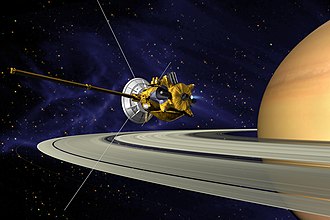Cassini–Huygens
Cassini–Huygens was a collaborative NASA-ESA-ASI (Italian Space Agency) mission designed to study the Saturn system, including its rings and natural satellites. Launched on October 15, 1997, from Cape Canaveral Air Force Station, the mission consisted of two main elements: the Cassini orbiter, named after the Italian-French astronomer Giovanni Domenico Cassini who discovered four of Saturn's moons, and the Huygens probe, named after the Dutch astronomer Christiaan Huygens who discovered Titan, Saturn's largest moon. The mission's primary objectives were to explore Saturn's complex ring system, the composition and structure of its moons, and the planet's magnetic environment.
Mission Overview
The Cassini–Huygens mission was one of the most ambitious and successful interplanetary exploration missions ever undertaken. After a nearly seven-year journey, Cassini entered Saturn's orbit on July 1, 2004. The Huygens probe separated from the orbiter on December 25, 2004, and landed on Titan on January 14, 2005, marking the first landing ever accomplished in the outer Solar System.
Cassini Orbiter
The Cassini orbiter was equipped with 12 scientific instruments designed to study Saturn, its rings, moons, and magnetic environment. It conducted multiple flybys of Saturn's moons, including Enceladus, Iapetus, and Rhea, providing valuable data on their composition, surface features, and geologic activity. One of the orbiter's significant discoveries was the detection of water-ice geysers on Enceladus, suggesting the presence of a subsurface ocean capable of supporting microbial life.
Huygens Probe
The Huygens probe carried six instruments to study the atmosphere and surface of Titan. It descended through Titan's thick atmosphere, providing data on its composition, pressure, and temperature. The probe's instruments also captured images of Titan's surface, revealing a complex landscape of mountains, channels, and possible lakes of liquid hydrocarbons, offering insights into the moon's geologic and meteorologic processes.
Scientific Discoveries
The Cassini–Huygens mission made numerous groundbreaking discoveries during its time in the Saturn system. These include the detailed analysis of Saturn's rings, revealing their structure and the processes that shape them; the discovery of new moons orbiting Saturn; insights into the dynamic weather systems of Saturn and Titan; and the detection of prebiotic chemicals in Titan's atmosphere, suggesting the moon could potentially harbor or support life.
End of Mission
The Cassini mission concluded on September 15, 2017, with a planned descent into Saturn's atmosphere. This intentional end was chosen to prevent any potential contamination of Saturn's moons, which could harbor conditions suitable for life. The mission's legacy continues through the vast amount of data it returned, which scientists will analyze for years to come.
Legacy and Impact
The Cassini–Huygens mission has had a profound impact on our understanding of the outer Solar System, particularly the Saturn system. It has laid the groundwork for future exploration missions and has significantly contributed to the field of planetary science. The mission's success demonstrates the value of international collaboration in space exploration and has inspired a new generation of scientists and engineers.
This article is a space- or spaceflight-related stub. You can help WikiMD by expanding it!
Transform your life with W8MD's budget GLP-1 injections from $125.
W8MD offers a medical weight loss program to lose weight in Philadelphia. Our physician-supervised medical weight loss provides:
- Most insurances accepted or discounted self-pay rates. We will obtain insurance prior authorizations if needed.
- Generic GLP1 weight loss injections from $125 for the starting dose.
- Also offer prescription weight loss medications including Phentermine, Qsymia, Diethylpropion, Contrave etc.
NYC weight loss doctor appointments
Start your NYC weight loss journey today at our NYC medical weight loss and Philadelphia medical weight loss clinics.
- Call 718-946-5500 to lose weight in NYC or for medical weight loss in Philadelphia 215-676-2334.
- Tags:NYC medical weight loss, Philadelphia lose weight Zepbound NYC, Budget GLP1 weight loss injections, Wegovy Philadelphia, Wegovy NYC, Philadelphia medical weight loss, Brookly weight loss and Wegovy NYC
|
WikiMD's Wellness Encyclopedia |
| Let Food Be Thy Medicine Medicine Thy Food - Hippocrates |
Medical Disclaimer: WikiMD is not a substitute for professional medical advice. The information on WikiMD is provided as an information resource only, may be incorrect, outdated or misleading, and is not to be used or relied on for any diagnostic or treatment purposes. Please consult your health care provider before making any healthcare decisions or for guidance about a specific medical condition. WikiMD expressly disclaims responsibility, and shall have no liability, for any damages, loss, injury, or liability whatsoever suffered as a result of your reliance on the information contained in this site. By visiting this site you agree to the foregoing terms and conditions, which may from time to time be changed or supplemented by WikiMD. If you do not agree to the foregoing terms and conditions, you should not enter or use this site. See full disclaimer.
Credits:Most images are courtesy of Wikimedia commons, and templates, categories Wikipedia, licensed under CC BY SA or similar.
Contributors: Prab R. Tumpati, MD

